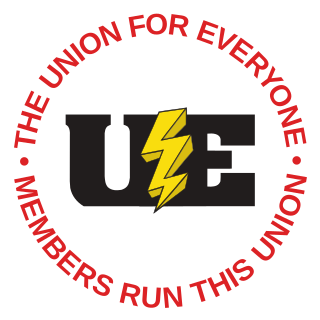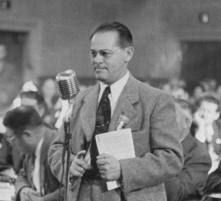Related Research Articles
The Communist Party USA and its allies played an important role in the United States labor movement, particularly in the 1930s and 1940s, but wasn't successful either in bringing the labor movement around to its agenda of fighting for socialism and full workers' control over industry, or in converting their influence in any particular union into membership gains for the Party. The CP has had only negligible influence in labor since its supporters' defeat in internal union political battles in the aftermath of World War II and the CIO's expulsion of the unions in which they held the most influence in 1950. After the expulsion of the Communists, organized labor in the United States began a steady decline.
The Communist Party (CP) and its allies played a role in the United States labor movement, particularly in the 1930s and 1940s, but largely wasn't successful either in bringing the labor movement around to its agenda or in converting their influence in any particular union into membership gains for the Party. The CP has had only negligible influence in labor since its supporters' defeat in internal union political battles in the aftermath of World War II and the Congress of Industrial Organizations's (CIO) expulsion of unions in which the party held the most influence in 1950. The expelled parties were often raided by stronger unions, and most withered away.

The American Federation of Labor was a national federation of labor unions in the United States that continues today as the AFL–CIO. It was founded in Columbus, Ohio, in 1886 by an alliance of craft unions eager to provide mutual support and disappointed in the Knights of Labor. Samuel Gompers was elected the full-time president at its founding convention and was re-elected every year except one until his death in 1924. He became the major spokesperson for the union movement.

The nature and power of organized labor in the United States is the outcome of historical tensions among counter-acting forces involving workplace rights, wages, working hours, political expression, labor laws, and other working conditions. Organized unions and their umbrella labor federations such as the AFL–CIO and citywide federations have competed, evolved, merged, and split against a backdrop of changing values and priorities, and periodic federal government intervention.

William Z. Foster was a radical American labor organizer and Communist politician, whose career included serving as General Secretary of the Communist Party USA from 1945 to 1957. He was previously a member of the Socialist Party of America and the Industrial Workers of the World, leading the drive to organize packinghouse industry workers during World War I and the steel strike of 1919.
Amalgamated Clothing Workers of America (ACWA) was a United States labor union known for its support for "social unionism" and progressive political causes. Led by Sidney Hillman for its first thirty years, it helped found the Congress of Industrial Organizations. It merged with the Textile Workers Union of America (TWUA) in 1976 to form the Amalgamated Clothing and Textile Workers Union (ACTWU), which merged with the International Ladies' Garment Workers' Union in 1995 to create the Union of Needletrades, Industrial and Textile Employees (UNITE). UNITE merged in 2004 with the Hotel Employees and Restaurant Employees Union (HERE) in 2004 to create a new union known as UNITE HERE. After a bitter internal dispute in 2009, the majority of the UNITE side of the union, along with some of the disgruntled HERE locals left UNITE HERE, and formed a new union named Workers United, led by former UNITE president Bruce Raynor.

The United Electrical, Radio and Machine Workers of America (UE), is an independent democratic rank-and-file labor union representing workers in both the private and public sectors across the United States.

The International Fur and Leather Workers Union (IFLWU), was a labor union that represented workers in the fur and leather trades.

The Oil, Chemical and Atomic Workers Union (OCAW) was a trade union in the United States which existed between 1917 and 1999. At the time of its dissolution and merger, the International represented 80,000 workers and was affiliated with the AFL–CIO.
The Trade Union Unity League (TUUL) was an industrial union umbrella organization under the Communist Party of the United States (CPUSA) between 1929 and 1935. The group was an American affiliate of the Red International of Labor Unions. The formation of the TUUL was the result of the Communist International's Third Period policy, which ordered affiliated Communist Parties to pursue a strategy of dual unionism and thus abandon attempts at "bore from within" existing trade unions. TUUL unions aimed to organize semi-skilled and unskilled workers, many whom had been expelled from the American Federation of Labor (AFL). According to the TUUL, the AFL was "an instrument of the capitalists for the exploitation of the workers." Thus, the TUUL was formed as an organization in opposition to the AFL."

Emil Rieve was an American labor leader. He was president of the Textile Workers Union of America (TWUA) from 1939 to 1956, a vice president of the Congress of Industrial Organizations (CIO) from 1939 to 1955, and a vice president of the AFL-CIO from 1955 to 1960.

Benjamin Gold (1898–1985) was an American labor leader and Communist Party member who was president of the International Fur and Leather Workers Union (IFLWU) from 1937 to 1955.
Morgen Freiheit was a New York City-based daily Yiddish language newspaper affiliated with the Communist Party, USA, founded by Moissaye Olgin in 1922. After the end of World War II the paper's pro-Israel views brought it into disfavor with the Communist Party and its editor Paul Novick was expelled from the organization. The paper closed in 1988.

The Lovestoneites, led by former General Secretary of the Communist Party USA (CPUSA) Jay Lovestone, were a small American oppositionist communist movement of the 1930s. The organization emerged from a factional fight in the CPUSA in 1929 and unsuccessfully sought to reintegrate with that organization for several years.
The United Public Workers of America (1946–1952) was an American labor union representing federal, state, county, and local government employees. The union challenged the constitutionality of the Hatch Act of 1939, which prohibited federal executive branch employees from engaging in politics. In United Public Workers of America v. Mitchell, 330 U.S. 75 (1947), the Supreme Court of the United States upheld the Hatch Act, finding that its infringement on the Constitutional rights was outweighed by the need to end political corruption. The union's leadership was Communist, and in a famous purge the union was ejected from its parent trade union federation, the Congress of Industrial Organizations, in 1950.

The Congress of Industrial Organizations (CIO) was a federation of unions that organized workers in industrial unions in the United States and Canada from 1935 to 1955. Originally created in 1935 as a committee within the American Federation of Labor (AFL) by John L. Lewis, a leader of the United Mine Workers (UMW), and called the Committee for Industrial Organization. Its name was changed in 1938 when it broke away from the AFL. It focused on organizing unskilled workers, who had been ignored by most of the AFL unions.
Morris Iushewits or Iushewitz was a union activist and leader of the Newspaper Guild, the Congress of Industrial Organizations (CIO), and the American Federation of Labor and Congress of Industrial Organizations (AFL–CIO).
A union raid is when a challenger or outsider union tries to take over the membership base of an existing incumbent union, typically through a union raid election in the United States and Canada.
The United Farm Equipment and Metal Workers of America (FE) was a labor union representing workers in two related industries in the United States and Canada.
References
- 1 2 3 Cornell University IRL School. Chapter 10 - Clothing and Textiles, pp. 259-299
- 1 2 The Miami News, June 22, 1935. Communists take control of fur union [ permanent dead link ]
- ↑ Craig Phelan (January 1989). William Green: Biography of a Labor Leader. SUNY Press. p. 36. ISBN 978-0-88706-870-6.
- ↑ Judith Stepan-Norris; Maurice Zeitlin (2003). Left Out: Reds and America's Industrial Unions. Cambridge University Press. p. 57. ISBN 978-0-521-79840-2.
- ↑ Judith Stepan-Norris; Maurice Zeitlin (2003). Left Out: Reds and America's Industrial Unions. Cambridge University Press. p. 52. ISBN 978-0-521-79840-2.